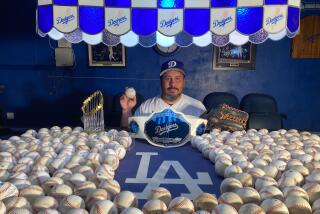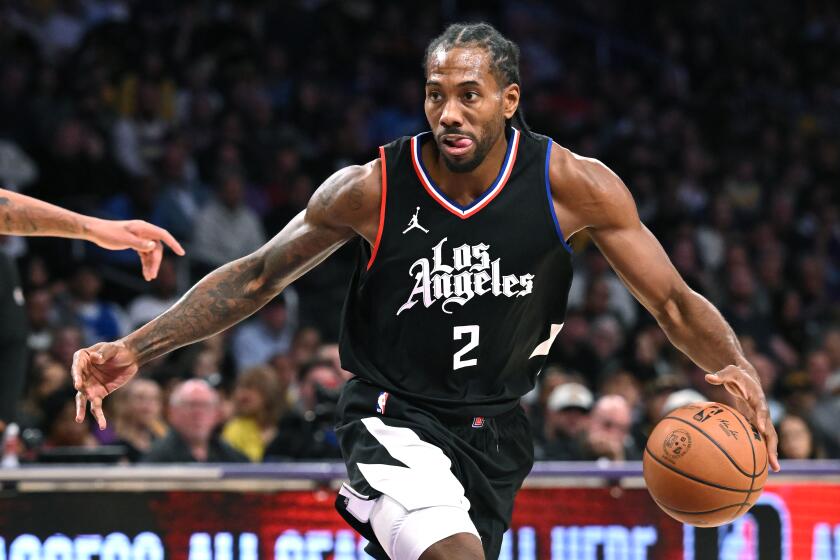Floyd Landis follows a road taken by previous whistleblowers
Call them what you will. Crusaders or snitches. Or blatant liars.
When Floyd Landis leveled doping accusations against Lance Armstrong and other top cyclists last week, he was following in well-trodden footsteps.
Trace the path back through NFL lineman Lyle Alzado’s heartfelt mea culpa and Jose Canseco’s promoting a tell-all book by estimating that 85% of major league ballplayers use performance-enhancing drugs.
The whistleblowers don’t always have evidence but that hasn’t stopped them from speaking out.
They have alternately been hailed for their candor and dismissed as attention-seekers. In more than a few cases, their claims have eventually proved true.
Either way, the steroid era has created a new tradition of finger-pointing.
“This is just the latest chapter in a long-running soap opera,” said John Hoberman, a University of Texas professor who has studied doping. “It’s a very frustrating story.”
For much of the history of American sports, what happened in the locker room stayed in the locker room.
“Athletes were expected to honor the code,” said Jay Coakley, author of “Sports in Society: Issues and Controversies.” “They were not going to speak.”
That imperative began to erode in 1970 when major league pitcher Jim Bouton published his behind-the-scenes diary, “Ball Four.” The popular book included plenty of details, including Mickey Mantle stepping to the plate hung over — salacious stuff at the time.
Since then, the standard has been raised. It takes more than barroom tales or corked bats to arouse public outrage.
“There’s a fine line,” Coakley said. “Fans generally have a hard time accepting anything that involves modifying the body chemically.”
Enter Landis, who was scheduled to hold a news conference in Los Angeles on Saturday but canceled at the last moment.
After failing a drug test, the cyclist was stripped of his 2006 Tour de France title and suspended for two years. He vehemently denied the accusations, even wrote a book insisting he was innocent.
His story changed last week when he acknowledged cheating and revealed that he had sent e-mails to cycling and anti-doping organizations in which he accused Armstrong of doping, showing other riders how to dope and bribing an official after allegedly testing positive in 2002.
According to the Wall Street Journal, Landis also cooperated with investigators from the Food and Drug Administration’s criminal investigations unit.
Though Armstrong has never been cited with a positive test, the seven-time Tour de France winner has faced such allegations before. He has repeatedly denied wrongdoing and now says that Landis is seeking revenge for perceived slights.
“He has no proof,” Armstrong said. “It’s just our word against his, and we like our word. We like where we stand.”
Cycling officials have raised a similar point: After years of lying about his own use of banned substances, is Landis a credible witness and will his claims hold up in the court of public opinion?
“If it’s someone who has a long-standing history of honor and integrity, the accusations are going to stick a lot more quickly and easily,” said Michael Gordon, a crisis management consultant with Group Gordon Strategic Communications in New York.
But Hoberman points out that innocent athletes aren’t likely to have inside knowledge of wrongdoing.
“The police rely on bad guys for information all the time,” he said. “The CIA depends on even worse people.”
The sports world is no different.
In 1985, Pittsburgh Steelers lineman Steve Courson admitted to steroid use and became one of the first whistleblowers of the doping era with an article in Sports Illustrated.
Though the league subsequently began disciplining players for use of performance-enhancing drugs — and Raiders lineman Alzado followed with a similar story about himself and his teammates — Courson was shunned by football.
Almost 20 years later, Canseco estimated that a vast majority of ballplayers took steroids. Given his reputation, and the fact he was promoting an autobiography, his accounts were widely dismissed.
“Audiences are really schizophrenic,” said Mark Dyreson, a Penn State kinesiology professor who specializes in sports and culture. “They want to hear but they don’t want to know. And they’re always looking at the motives of the whistleblower.”
The same goes for accusations that fall outside the realm of doping.
Tim Donaghy, the NBA referee caught up in a gambling scandal, alleged that fellow officials had affected the outcome of two playoff series — including the Lakers vs. Sacramento Kings in 2002 — for the sake of boosting revenue and television ratings.
His claims seemed to gain little or no traction among fans.
In the early 1980s, professor Jan Kemp was fired by the University of Georgia after making accusations about preferential treatment for athletes who were failing courses.
Kemp won redemption by way of a $1.08-million judgment against the school and was reinstated. The university and the NCAA eventually toughened academic standards.
But the results aren’t always so clear-cut in the secretive world of doping.
In 2003, track coach Trevor Graham quietly sent a syringe containing a new designer steroid to the U.S. Anti-Doping Agency, which led investigators to BALCO.
The ensuing scandal ensnared track stars Marion Jones and Tim Montgomery, among others.
Though the evidence Graham provided helped boost anti-doping enforcement, the U.S. Olympic Committee eventually banned him from its facilities because of his links to more than half a dozen athletes sanctioned or implicated in doping offenses.
To some degree, Landis now benefits from those who came before. For all the negative public reaction Canseco endured, much of what he alleged has since proved true.
Given cycling’s checkered past, Landis might also get some benefit of the doubt.
“He’s not claiming he saw a pink armadillo reading a book,” Hoberman said. “He is claiming what is actually pretty routine stuff.”
Which makes him part of the new world of sports.
“We’ve become used to wanting the inside story,” Dyreson said. “There has been a blurring of the line between sport and entertainment — it’s like Hollywood.”
twitter.comLATimesWharton
More to Read
Get our high school sports newsletter
Prep Rally is devoted to the SoCal high school sports experience, bringing you scores, stories and a behind-the-scenes look at what makes prep sports so popular.
You may occasionally receive promotional content from the Los Angeles Times.







